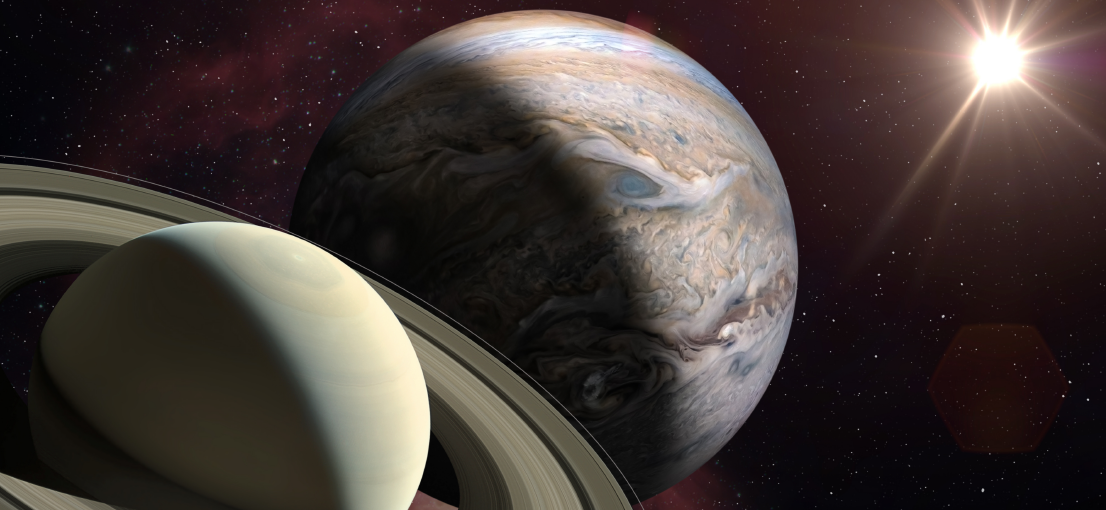In Astronomy, conjunction refers to the observation that two astronomical objects are very close in the sky when observed from a specific object such as Earth. When a conjunction occurs, the locations of the two objects have either the same right ascension or the same ecliptic longitude as observed from Earth. "Great conjunction" is a conjunction of the planets Jupiter and Saturn, it is named "great" for being by far the rarest of the conjunctions between planets that are visible from Earth. In December 2020, there was a rare great conjunction over the sky of Hong Kong. At that time, the separation between Jupiter and Saturn, as observed from Earth was only 6.1 arcminutes. The last time a great conjunction with separation less than 10 arcminutes traced back to 1623.
How rare is a great conjunction, in particular the 2020 one?
The orbital period of Jupiter is about 11.9 years and that of Saturn is about 29.5 years. This makes a five to two resonance period between the two planets, that is, Jupiter will orbit the Sun five times while Saturn will orbit twice. As observed from Earth, great conjunction occurs once every 20 years, it is rare compared with conjunctions of other planets. For example, the conjunction of Mercury and Venus occurs every 1.6 years, the conjunction of Jupiter and Mars occurs every 2.2 years. The great conjunction in 2020 attracted many astronomical enthusiasts, not only because the separation is small, but also it can be observed with naked-eyes. However, not all great conjunctions are observable. The orbits of these two planets are different, causing different separation each time they conjunct. A closer conjunction occurs once every 60 years, a conjunction with similar separation like this one may take 400 years to occur. The visibility of a great conjunction may also be affected by seasons, weather and location of the conjunction. The last time a great conjunction could be seen with bare-eyes and the separation of planets was that close occurred in 1226. In the past 800 years or so, two great conjunctions, in 1563 and 1623 respectively had separations less than 10 arcminutes. However, it was difficult to watch these two great conjunctions because the directions were too close to the Sun, thus making them difficult to be observed. The next great conjunction with such small separation will not happen until 2080.
The Great Conjunction and the Star of Bethlehem
In the ancient time, people predicted the future by observing the changes of astronomical phenomenon. They thought that the astronomical wonders were signals to mankind. In the "Gospel of Matthew" in the New Testament, it was mentioned that when Jesus was born, there was a very bright star in the sky and illuminating the entire Bethlehem. The biblical Magi were inspired by the star to travel to Jerusalem to pay homage to Jesus and the bright star was "the Star of Bethlehem". The real identity of the star has been a fascinating puzzle for astronomers and enthusiasts to solve with and they proposed various hypotheses to affirm that the "Star of Bethlehem" was real since ancient time.
In the early 17th century, a famous German astronomer Mr. Johannes Kepler discovered the laws of planetary motion. He was the first man to propose that the "Star of Bethlehem" might have been the occurrence of a great conjunction in 7BC when there were three great conjunctions in late May, late September and early December. Although the hypotheses were invalidated later, it inspired the idea that the "Star of Bethlehem" might be an astronomical phenomenon. In the recent era, via the astronomy software calculation, astronomers Mr. Ernest Martin and Mr. Cragi Chester deduced that the "Star of Bethlehem" was the great conjunction of Jupiter and Saturn in 3BC. The "Star of Bethlehem" was considered a very bright star since the two planets were very close to each other.
Yet, the hypotheses mentioned above cannot be validated since there is no conclusive historical record of the actual birthday of Jesus. Perhaps the mysterious veil of this star will be lifted when the science is more advanced in the future.
January 2020

